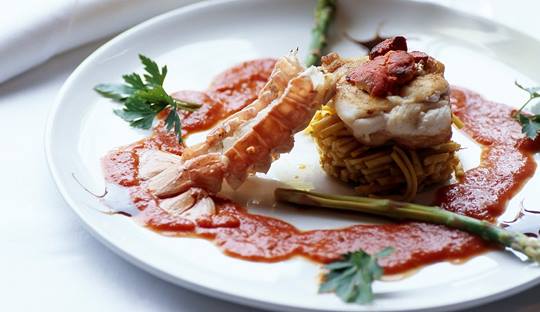Gastronomy
Photo: Páll Steffansson / www.visitfaroeislands.com/
For centuries the Faroese kitchen has developed a very distinct cuisine, due to its limitations and possibilities in terms of climate and resources. As the climate is not conducive to the cultivation of corn, Faroese food is characterised by the distinct variations in the preparations of various fish, shellfish and lamb.
Skerpikjøt
A Faroese delicacy is “Skerpikjøt”. Skerpikjøt is a variety of wind dried mutton made from lamb, which has been hang dried 5 – 9 months in a “hjallur”, a house built for specifically for this purpose, where the salty, north Atlantic wind blows through. Depending on the length of the process the taste will be various degrees of woolly and fermented. The meat goes through three stages.
-
“Visnaður” transpires within the first few days. The meat is not considered edible during this stage.
-
When the mutton reaches “Ræstur”, it is considered edible without cooking. However, the “Ræstur”-meat is primarily used in soups.
-
The last and final stage is called “turrur”. Turrur meat is often thinly sliced and eaten on an open rye bread sandwich.
Almost 70.000 sheep populate the faroe islands and a majority of a slaughtered sheep are used for Skerpikjøt.
Fish, Shellfish and Birds
As it is Faroese tradition that food is not sold, freshly caught fish are rarely sold in supermarkets but are bought directly from boats or obtained for free from family and friends.
The Faroese salmon is especially fat, loaded with omega 3 and particularly tasty, as it is bred in a spacious stress-free environment, tempered water and natural rivers. Additional fish on the Faroe Islands include halibut, angler, mackerel and cod. The Faroese cod is often highlighted and praised as it is sometimes mistaken for a shellfish due to its texture.
Faroese shellfish is considered a delicacy and gourmet restaurants worldwide use the enormous Faroese lobsters. Additionally sea urchin, king crab and a variety of mussels and clams are caught in the Faroese waters.
Faroese fish specialities include:
-
Fiskaknettir - a type of fish balls boiled with sheep fat.
-
Knettasúpan – is a soup made on Fiskaknettir.
-
Fiskakøka – is a fishcake resembling a pudding.
The Atlantic Puffin is a key in ingredient in several traditional Faroese dishes and is still used today. It is only permitted to hunt and catch the birds during specific periods. The birds are hunted and caught with the traditional Faroese fleygastong.
Whales
Traditionally whale used to be an important source of food throughout winter, but due to the high amounts of mercury, it is eaten to a lesser degree. As it is impossible to know when the whales are near, the Faroese have to wait until the whales get close enough to the fjords to chase them in. The Faroese whaling is strictly regulated by Faroese authorities, approved by the IWC and is not done commercially.
Torshavn boasts a selection of very good and diverse restaurants, serving everything from traditional Faroese food to sushi and New Nordic Food.
To read more about the food culture of the Faroe Islands, visit: https://visitfaroeislands.com/en/about1/people-society/faroese-food

